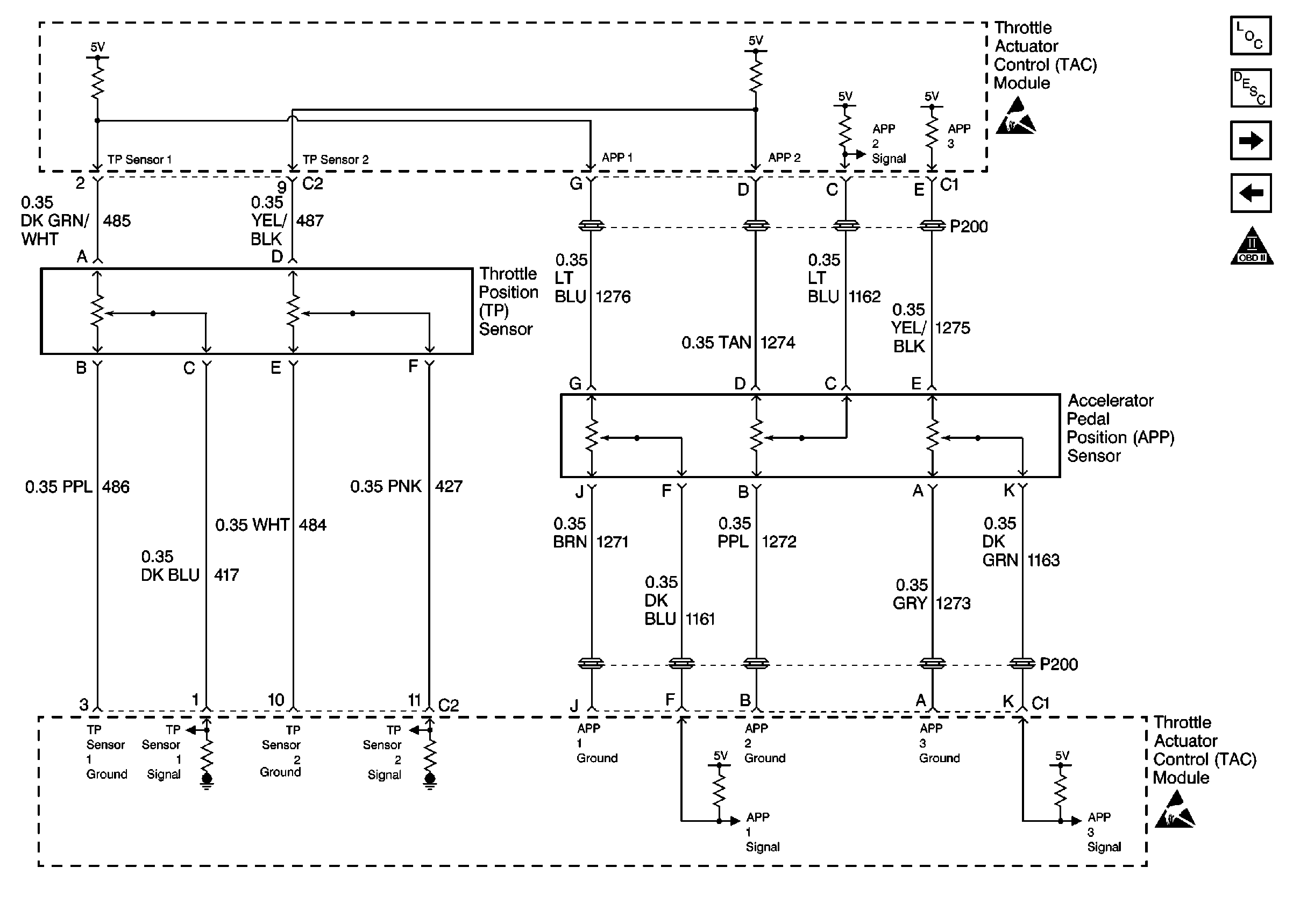Refer to
Cell 20: TP and APP Sensors

for complete circuit details.
Circuit Description
The accelerator pedal position (APP) sensor is mounted on the accelerator
pedal assembly. The sensor is actually 3 individual APP sensors within
one housing. Three separate signals, grounds, and 5 volt
reference circuits are used in order to connect the accelerator
pedal sensor assembly and the throttle actuator control (TAC) Module.
If only one APP sensor DTC is set, the redundant APP systems allow
the TAC system to continue operating normally. This DTC sets
if the PCM detects a condition with more than one APP sensor. One
APP sensor DTC will not cause the Reduced Engine Power message
to be displayed. Two APP sensor DTCs for the same sensor also will
not cause the Reduced Engine Power message to be displayed. However,
if two or more DTCs are set involving more than one APP sensor,
this DTC will set and the Reduced Engine Power message is displayed.
Conditions for Running the DTC
| • | DTCs P0606, P1517, P1518 are not set. |
| • | The ignition switch is in the crank or run position. |
| • | The ignition voltage is greater than 5.23 volts. |
Conditions for Setting the DTC
| • | Two or more APP sensors are out of range or all three APP sensors
disagree or one APP sensor is out of range and the other two APP sensors disagree. |
| • | All of the above conditions met for less than 1 second. |
Action Taken When the DTC Sets
| • | The PCM stores the DTC information into memory when the diagnostic
runs and fails. |
| • | The PCM illuminates the malfunction indicator lamp (MIL) when
the diagnostic runs and fails. |
| • | The PCM records the operating conditions at the time the diagnostic
fails. The PCM stores this information in the Freeze Frame and/or Failure
Records. |
| • | The TAC system operates in reduced engine power mode. If certain
TAC system DTCs are set at the same time, the TAC system may command the
engine to shut down. |
Conditions for Clearing the MIL/DTC
| • | The PCM turns OFF the malfunction indicator lamp (MIL) after
3 consecutive ignition cycles that the diagnostic runs and does not
fail. |
| • | A last test failed, or current DTC, clears when the diagnostic
runs and does not fail. |
| • | A history DTC clears after 40 consecutive warm-up cycles,
if no failures are reported by this or any other emission related diagnostic. |
| • | Use a scan tool in order to clear the MIL and the DTC. |
Diagnostic Aids
Important:
| • | Remove any debris from the PCM\TAC module connector surfaces before
servicing the PCM\TAC module. Inspect the PCM\TAC module connector gaskets
when diagnosing/replacing the modules. Ensure that the gaskets
are installed correctly. The gaskets prevent contaminate intrusion
into the PCM\TAC modules. |
| • | For any test that requires probing the PCM or a component
harness connector, use the Connector Test Adapter Kit J 35616
. Using this kit prevents damage
to the harness/component terminals. Refer to
Using Connector Test Adapters
in Wiring Systems. |
| • | Inspect the TAC module connectors for signs of water intrusion.
When this occurs, multiple DTCs should be set and no circuit or component
conditions can be located. |
| • | The APP sensor 1 and the TP sensor 1 5.0 volt reference circuits
are internally connected within the TAC module. |
| • | The APP sensor 2 and the TP sensor 2 5.0 volt reference circuits
are internally connected within the TAC module. |
| • | When the TAC module detects a condition within the TAC System,
more than one TAC System related DTC may set. This is due to the many redundant
tests run continuously on this system. Locating and repairing
one individual condition may correct more than one DTC. Keep
this in mind when reviewing captured DTC info. |
| • | For an intermittent, refer to
Symptoms
. |
Test Description
The numbers below refer to the step numbers on the diagnostic table.
-
When the conditions are corrected which are causing the APP sensor DTCs
to set, the status of this DTC will change to History.
When the TAC module detects a problem within the TAC System, more than
one TAC System related DTC may set. This is due to the many redundant
tests run continuously on this system. Locating and repairing
one individual problem may correct more than one DTC. Keep this
in mind when reviewing captured DTC info.

